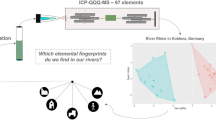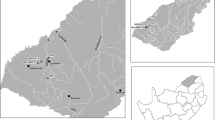Abstract
We have conducted an interlaboratory comparison study for total mercury and methylmercury analysis in natural (unspiked) water samples annually for the past 4 years. The samples were primarily freshwater, with the exception of one coastal seawater sample in 2014. The study provided participants with an opportunity to assess the quality of their measurements and the intercomparability of their data with their peers. Data on analytical methods used were collected and used to determine whether any methods yield biased results and should be discontinued. The majority of participants received performance scores of 3 or higher, indicating satisfactory performance and results close to the consensus means. However, the coefficients of variation between labs were greater than 20 % in most cases, which may not be sufficiently precise for multilaboratory environmental research, where the processes being studied may vary by 20 % or less. Total mercury analysis methods that do not use gold amalgamation were shown to be underperforming relative to those that do. No significant correlation was observed between sample storage time or temperature and total mercury recovery. Methylmercury analysis methods that do not use distillation performed poorly relative to those that use distillation.











Similar content being viewed by others
References
Bloom, N. S., Horvat, M., & Watras, C. J. (1995). Results of the international aqueous mercury speciation intercomparison exercise. Water, Air, & Soil Pollution, 80(1), 1257–1268. Accessed 28 February 2013.
Chandrasekhar, T. M. (2003). Evaluation of Fluorinated Polyethylene Bottles for Sample Storage (p. 22). Tallahassee: Florida Department of Environmental Protection.
Chiasson-Gould, S. A., Blais, J. M., & Poulain, A. J. (2014). Dissolved organic matter kinetically controls mercury bioavailability to bacteria. Environmental Science & Technology, 48(6), 3153–3161. doi:10.1021/es4038484.
Cook, R. D., & Weisberg, S. (1980). Characterizations of an empirical influence function for detecting influential cases in regression. Technometrics, 495–508.
Cossa, D., & Courau, P. (1990). An international intercomparison exercise for total mercury in seawater. Applied Organometallic Chemistry, 4(1), 49–54. doi:10.1002/aoc.590040109.
Creswell, J., Carter, A., & Davies, C. (2011). 2011 Brooks rand labs interlaboratory comparison study for total mercury and methylmercury (Intercomp 2011) (p. 44). Seattle, WA USA: Brooks Rand Labs. http://www.brooksrandinc.com/InstrumentManufacturingHome/2011%20Brooks%20Rand%20Labs%20Interlaboratroy%20Comparision%20Sutdy.pdf. Accessed 29 December 2014
Creswell, J., Engel, V., Carter, A., & Davies, C. (2012). 2012 Brooks rand labs interlaboratory comparison study for total mercury and methylmercury (Intercomp 2012) (p. 52). Seattle, WA USA: Brooks Rand Labs. http://www.brooksrandinc.com/InstrumentManufacturingHome/2012%20Brooks%20Rand%20Labs%20Interlaboratory%20Comparison%20Study.pdf. Accessed 29 December 2014
Creswell, J., Engel, V., Carter, A., & Davies, C. (2013). 2013 brooks rand instruments interlaboratory comparison study for total mercury and methylmercury (Intercomp 2013) (p. 51). Seattle, WA USA: Brooks Rand Instruments. http://www.brooksrandinc.com/InstrumentManufacturingHome/ILC2013%20Report.pdf. Accessed 15 May 2014
Creswell, J., Metz, J., Carter, A., & Davies, C. (2014). 2014 Brooks Rand Instruments Interlaboratory Comparison Study for Total Mercury and Methylmercury (Intercomp 2014) (p. 54). Seattle, WA USA: Brooks Rand Instruments. http://www.brooksrandinc.com/InstrumentManufacturingHome/ILC2014%20Report.pdf. Accessed 15 May 2014
Fadini, P. S., & Jardim, W. F. (2000). Storage of natural water samples for total and reactive mercury analysis in PET bottles. Analyst, 125(3), 549–551. doi:10.1039/A909623J.
Filliben, J. J. (2012). Chapter 1. Exploratory data analysis. In C. Croarkin& P. Tobias (Eds.), NIST/SEMATECH e-Handbook of Statistical Methods. http://www.itl.nist.gov/div898/handbook/. Accessed 8 May 2012
Fitzgerald, W. F., & Gill, G. A. (1979). Subnanogram determination of mercury by two-stage gold amalgamation and gas phase detection applied to atmospheric analysis. Analytical Chemistry, 51(11), 1714–1720. Accessed 1 April 2013.
Hall, G. E. M., Pelchat, J. C., Pelchat, P., & Vaive, J. E. (2002). Sample collection, filtration and preservation protocols for the determination of “total dissolved” mercury in waters. Analyst, 127(5), 674–680. doi:10.1039/B110491H.
Hammerschmidt, C. R., Bowman, K. L., Tabatchnick, M. D., & Lamborg, C. H. (2011). Storage bottle material and cleaning for determination of total mercury in seawater. Limnology and Oceanography: Methods, 9, 426–431. doi:10.4319/lom.2011.9.426.
Harris, R. C., Rudd, J. W. M., Amyot, M., Babiarz, C. L., Beaty, K. G., Blanchfield, P. J., et al. (2007). Whole-ecosystem study shows rapid fish-mercury response to changes in mercury deposition. Proceedings of the National Academy of Sciences, 104(42), 16586–16591. Accessed 17 December 2012.
Helsel, D. R. (2006). Fabricating data: how substituting values for nondetects can ruin results, and what can be done about it. Chemosphere, 65(11), 2434–2439. doi:10.1016/j.chemosphere.2006.04.051.
Helsel, D. R. (2010). Summing nondetects: incorporating low-level contaminants in risk assessment. Integrated Environmental Assessment and Management, 6(3), 361–366. doi:10.1002/ieam.31.
Horvat, M., Liang, L., & Bloom, N. S. (1993). Comparison of distillation with other current isolation methods for the determination of methyl mercury compounds in low level environmental samples: Part II. Water. Anal Chim Acta, 282(1), 153–168. Accessed 26 June 2014.
Lamborg, C. H., Hammerschmidt, C. R., Gill, G. A., Mason, R. P., & Gichuki, S. (2012). An intercomparison of procedures for the determination of total mercury in seawater and recommendations regarding mercury speciation during GEOTRACES cruises. Limnology and Oceanography: Methods, 10, 90–100. doi:10.4319/lom.2012.10.90.
Lepine, L., & Chamberland, A. (1995). Field sampling and analytical intercomparison for mercury and methylmercury determination in natural-water. Water, Air, and Soil Pollution, 80(1–4), 1247–1256. doi:10.1007/BF01189788.
Lin, P. E., & Niu, X. F. (1998). Statistical analysis of environmental laboratory data (Technical Report No. LAB012) (p. 41). Tallahassee: Florida Department of Environmental Protection.
Lin, P. E., & Niu, X.-F. (2002). Statistical Analysis and Summary of Mercury data, Inter-laboratory Comparison Program. Technical Report submitted to the Florida Department of Environmental Protection.(Contract LAB018).
Morel, F. M. M., Kraepiel, A. M. L., & Amyot, M. (1998). The chemical cycle and bioaccumulation of mercury. Annual review of ecology and systematics, 543–566. Accessed 20 June 2012.
Niu, X.-F., & Miller, D. (2009). Statistical analysis and summary of the HgRR9 mercury round robin data (Technical Report No. LAB027) (p. 32). Tallahassee, FL: Florida Department of Environmental Protection. http://publicfiles.dep.state.fl.us/dear/sas/roundrobin/hg/hgrr9.pdf
Niu, X.-F., & Tintle, A. (2003). Statistical Analysis and Summary of the HgRR3 Mercury Round Robin Data (Technical Report No. LAB020) (p. 30). Tallahassee: Florida Department of Environmental Protection. http://publicfiles.dep.state.fl.us/dear/sas/roundrobin/hg/hg3report.pdf
Niu, X.-F., & Tintle, A. (2004a). Statistical Analysis and Summary of the HgRR4 Mercury Round Robin Data (p. 29). Florida Department of Environmental Protection. http://publicfiles.dep.state.fl.us/dear/sas/roundrobin/hg/hgrr4.pdf. Accessed 15 May 2014
Niu, X.-F., & Tintle, A. (2004b). Statistical Analysis and Summary of the HgRR5 Mercury Round Robin Data (p. 29). Tallahassee, FL: Florida Department of Environmental Protection. http://publicfiles.dep.state.fl.us/dear/sas/roundrobin/hg/hgrr5.pdf. Accessed 15 May 2014
Niu, X.-F., & Tintle, A. (2005). Statistical Analysis and Summary of the HgRR6 Mercury Round Robin Data (p. 29). Tallahassee, FL: Florida Department of Environmental Protection. http://publicfiles.dep.state.fl.us/dear/sas/roundrobin/hg/hgrr6.pdf. Accessed 15 May 2014
Niu, X.-F., & Tintle, A. (2006). Statistical Analysis and Summary of the HgRR7 Mercury Round Robin Data (p. 29). Tallahassee, FL: Florida Department of Environmental Protection. http://publicfiles.dep.state.fl.us/dear/sas/roundrobin/hg/hgrr7.pdf. Accessed 15 May 2014
Niu, X.-F., & Tintle, A. (2008). Statistical Analysis and Summary of the HgRR8 Mercury Round Robin Data (Technical Report No. LAB027) (p. 30). Tallahassee, FL: Florida Department of Environmental Protection. http://publicfiles.dep.state.fl.us/dear/sas/roundrobin/hg/hgrr8.pdf
Olafsson, J. (1978). Report on the ices international intercalibration of mercury in seawater. Marine Chemistry, 6(1), 87–95. doi:10.1016/0304-4203(78)90009-9.
Olafsson, J. (1982). An international intercalibration for mercury in seawater. Marine Chemistry, 11(2), 129–142. doi:10.1016/0304-4203(82)90037-8.
Olson, M. L., Cleckner, L. B., Hurley, J. P., Krabbenhoft, D. P., & Heelan, T. W. (1997). Resolution of matrix effects on analysis of total and methyl mercury in aqueous samples from the Florida Everglades. Fresenius' Journal of Analytical Chemistry, 358(3), 392–396. doi:10.1007/s002160050435.
Quevauviller, P., Kramer, K. J. M., vander Vlies, E. M., Dorten, W., & Griepink, B. (1996). Interlaboratory studies to improve the quality of mercury determination in seawater. Fresenius' Journal of Analytical Chemistry, 356(7), 411–415.
R Foundation for Statistical Computing. (2014). R: A language and environment for statistical computing. Vienna, Austria. http://www.R-project.org/
Schiel, D., & Rienitz, O. (2010). EURAMET Project 924 part 3: Determination of Hg, Cd, Ni, and Pb in natural water at concentration levels required by the European Water Framework Directive (No. EURAMET Project 924 part 3). Braunschweig, Germany: Physikalisch-TechnischeBundesanstalt. http://www.euramet.org/fileadmin/docs/projects/924_METCHEM_Part_3_Final_Report.pdf. Accessed 29 December 2014
Schiel, D., & Rienitz, O. (2011). CCQM-K70: Determination of Hg in natural water at a concentration level required by the European environmental quality standard (EQS). Braunschweig, Germany: Physikalisch-TechnischeBundesanstalt. doi:10.1088/0026-1394/48/1A/08011
Selin, N. E. (2009). Global biogeochemical cycling of mercury: A review. Annual Review of Environment and Resources, 34, 43–63. doi:10.1146/annurev.environ.051308.084314.
Sugawara, K. (1978). Interlaboratory comparison of the determination of mercury and cadmium in sea and fresh waters. Deep Sea Research, 25(3), 323–332.
U.S. Environmental Protection Agency. (1998). Method 1630: Methyl Mercury in Water by Distillation, Aqueous Ethylation, Purge and Trap, and Cold Vapor Atomic Fluorescence Spectrometry (Analytical Method). Washington, DC: U.S. Environmental Protection Agency. http://water.epa.gov/scitech/methods/cwa/metals/mercury/upload/2007_07_10_methods_method_mercury_1630.pdf. Accessed 29 December 2014
U.S. Environmental Protection Agency. (2002). Method 1631, Revision E: Mercury in Water by Oxidation, Purge and Trap, and Cold Vapor Atomic Fluorescence Spectrometry (Analytical Method No. EPA-821-R-02-019). Washington, DC: U.S. Environmental Protection Agency. http://water.epa.gov/scitech/methods/cwa/metals/mercury/upload/2007_07_10_methods_method_mercury_1631.pdf. Accessed 29 December 2014
Yu, L.-P., & Yan, X.-P. (2003). Factors affecting the stability of inorganic and methylmercury during sample storage. TrAC, Trends in Analytical Chemistry, 22(4), 245–253. doi:10.1016/S0165-9936(03)00407-2.
Acknowledgments
A great many people have made the Intercomps possible, including all study participants. We especially thank John De Wild at USGS Middleton, Wisconsin, Becky Thorsness and Frank McFarland at Brooks Rand Labs and Milena Horvat at the Jožef Stefan Institute for serving as holding time labs. We thank James FrederickLindenfelser, Jennie Kim, and Candace Kittleson for managing the study logistics. We thank Brittany Nelson, Nathan Andersen, and Frank McFarland for their insight and advice into the statistical analysis. We thank Tricie Hunter and Anna Story for the financial management of the studies. This manuscript was greatly improved by the feedback of two anonymous reviewers.
Conflicts of Interest
Brooks Rand Instruments, the employer of four of the five authors of this paper, is the manufacturer of some of the analytical instruments used by participants in the Intercomps. In addition, Brooks Rand Instruments is a manufacturer of analytical standards for total mercury and methylmercury, which were used by some participants. Brooks Rand Labs, the employer of second author Ms. Carter, is owned in part by Colin Davies, an author on this paper and the owner of Brooks Rand Instruments. The authors carefully designed the methods of this study as outlined in “Section 2” to prevent this conflict of interest from having any influence on the results.
Author information
Authors and Affiliations
Corresponding author
Electronic Supplementary Material
Five additional tables and 13 additional figures are available as ESI. These include: Table S1 – Rating system for laboratory performance; Tables S2-S5 – Lists of study participants 2011-2014; Figures S1-S5 – Examples of exploratory statistical plots used to assess improvements in dataset normality with outlier removal; Figures S6-S13 – Results from holding-time analyses for THg and MeHg 2011-2014.
ESM 1
(DOCX 149 kb)
Rights and permissions
About this article
Cite this article
Creswell, J.E., Carter, A., Engel, V.L. et al. An Interlaboratory Comparison for Total Mercury and Methylmercury in Water at Environmentally Relevant Concentrations. Water Air Soil Pollut 226, 128 (2015). https://doi.org/10.1007/s11270-015-2313-x
Received:
Accepted:
Published:
DOI: https://doi.org/10.1007/s11270-015-2313-x




